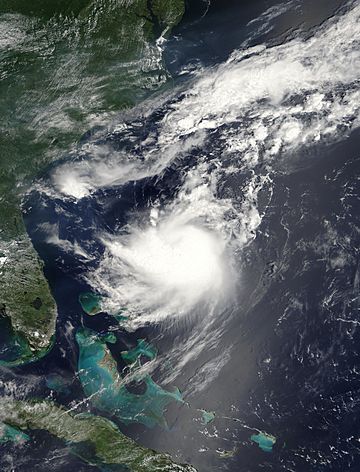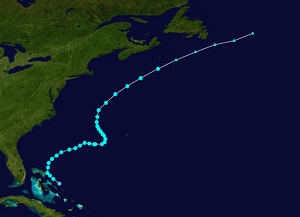Tropical Storm Franklin (2005) facts for kids
| Tropical storm (SSHWS/NWS) | |

Tropical Storm Franklin on July 23.
|
|
| Formed | July 21, 2005 |
|---|---|
| Dissipated | July 29, 2005 |
| Highest winds | 1-minute sustained: 70 mph (110 km/h) |
| Lowest pressure | 997 mbar (hPa); 29.44 inHg |
| Fatalities | None reported |
| Damage | None |
| Areas affected | Bahamas, Bermuda, Newfoundland |
| Part of the 2005 Atlantic hurricane season | |
Tropical Storm Franklin was a strong tropical storm. It spent most of its life in the western Atlantic Ocean. Franklin was the sixth named storm of the 2005 Atlantic hurricane season. It almost became a hurricane two times.
Tropical Storm Franklin started forming north of the Bahamas on July 21. It then moved across the western Atlantic. The storm came close to Bermuda on July 26. Later, Franklin changed into an extratropical cyclone near Newfoundland. It was then absorbed by another weather system. Franklin did not cause any damage or harm to people. This was because it stayed over the ocean for most of its journey.
Contents
Franklin's Journey: How the Storm Moved
A tropical wave began to form west of Africa on July 10. This wave reached the Bahamas on July 21. There, it grew stronger and became Tropical Depression Six. This happened about 70 miles (110 km) east of Eleuthera.
At first, experts thought the storm would move in a circle. They also thought it might move slowly west towards central Florida. However, soon after it formed, the depression became Tropical Storm Franklin.
Tropical Storm Franklin faced a lot of wind shear. This was due to another storm, Tropical Storm Gert, forming nearby. Forecasters at the National Hurricane Center thought Franklin might disappear. But the wind shear stopped as Franklin moved northeast. This allowed the storm to get stronger. Experts then believed Franklin could become a hurricane. They also thought it would pass very close to Bermuda.
On July 23, Tropical Storm Franklin reached its strongest point. It had winds of 70 mph (110 km/h).
Franklin then moved unevenly to the east. It started to weaken as the wind shear increased again. The NHC predicted the storm would break apart. But Franklin stopped weakening on July 25. It was still a weak tropical storm. The storm passed about 200 miles (325 km) west of Bermuda on July 26. It then moved slowly north into the warmer waters of the Gulf Stream.
The wind shear lessened once more. This helped Franklin get a bit stronger again. Its winds reached 60 mph (95 km/h) on July 28. Franklin then started to speed up towards the northeast. It became an extratropical cyclone on July 30, south of Newfoundland. The extratropical storm passed near the southern tip of Newfoundland later that day. It was then absorbed by a larger weather system on July 31.
What Impact Did Tropical Storm Franklin Have?
When Tropical Storm Franklin was forming, a tropical storm warning was given for the northwest Bahamas. But this warning was soon canceled. Franklin moved north and away from the islands. A tropical storm watch was also issued for Bermuda on July 25. This was canceled a day later when Franklin moved away.
Tropical Storm Franklin formed very close to land in the Bahamas. It also passed near Bermuda. However, there were no reports of strong tropical storm winds over land. The strongest wind gust recorded on Bermuda was 37 mph (60 km/h).
After Franklin became an extratropical storm, it affected parts of southeastern Newfoundland. It brought about 1 inch (25 mm) of rain to the area. Luckily, Tropical Storm Franklin caused no damage and no one was hurt.
Naming and Records for Franklin
When Franklin formed on July 21, it set a new record. It was the earliest in a season that the sixth tropical storm had ever formed. It broke the old record from 1936 by 14 days. This was the first time the name Franklin was used for a tropical storm. The name Hurricane Floyd from 1999 had been retired.
Because Tropical Storm Franklin did not cause any deaths or damage, its name was not retired. The World Meteorological Organization decided it could be used again. So, the name Franklin was on the list for the 2011 hurricane season.
Related pages
|
Tropical cyclones of the 2005 Atlantic hurricane season |
|||||||||||||||||||||||||||||||||||||||||||||||
|
|
||||||||||||||||||||||||||||||||||||||||||||||
|
|
|||||||||||||||||||||||||||||||||||||||||||||||
Images for kids
See also
 In Spanish: Tormenta tropical Franklin (2005) para niños
In Spanish: Tormenta tropical Franklin (2005) para niños



